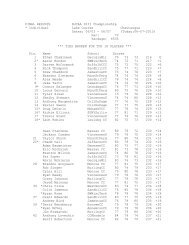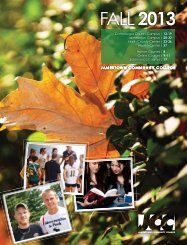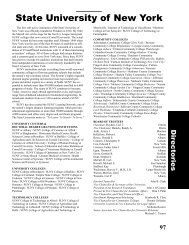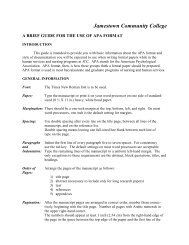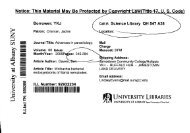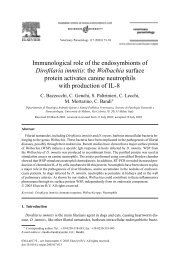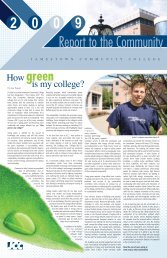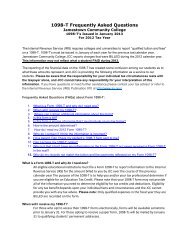Discrimination between six species of canine microfilariae by a ...
Discrimination between six species of canine microfilariae by a ...
Discrimination between six species of canine microfilariae by a ...
You also want an ePaper? Increase the reach of your titles
YUMPU automatically turns print PDFs into web optimized ePapers that Google loves.
timori (20%). Several<br />
studies <strong>of</strong> ITS2 regions in various helminths suggest<br />
that while intra-<strong>species</strong> variation can occur, it is less<br />
than inter-<strong>species</strong> variation, and that in most cases<br />
intra-<strong>species</strong> variation is limited to single nucleotide<br />
polymorphisms (Conole et al., 1999; Gasser et al.,<br />
1999a,b; Hu<strong>by</strong>-Chilton et al., 2001; Newton et al.,<br />
1998; Woods et al., 2000) and previous studies <strong>of</strong> other<br />
filariae show similar results (Gasser et al., 1996).<br />
These findings agree with our observations <strong>of</strong> ITS2<br />
variability in filariae and support our genotypic<br />
identification <strong>of</strong> B. malayi. Finally, it is possible that<br />
the sample <strong>of</strong> adult B. malayi provided for our study<br />
was incorrectly identified; however, phenotypic<br />
classification <strong>of</strong> filariae is generally more robust<br />
using adult filariae than micr<strong>of</strong>ilariae. The reason for<br />
the discrepancy <strong>between</strong> our data and that <strong>of</strong> Fischer<br />
et al. (2002) remains to be elucidated.<br />
Finally, we examined the ability <strong>of</strong> our pan-filarial<br />
primer sequences to amplify the 5.8S-ITS2-28S<br />
region from two additional filariae in silico. Analysis<br />
<strong>of</strong> published sequences for Onchocerca volvulus<br />
(Genbank # AF228575), and Mansonella ozzardi<br />
(Genbank # AF228554) demonstrated that our panfilarial<br />
primers should amplify 470 and 430 bp<br />
amplicons, respectively. This suggests that our primer<br />
set might be uniquely capable <strong>of</strong> amplifying DNA that<br />
can be used to genotype all filariae <strong>of</strong> the family<br />
Onchocercidae.<br />
We recommend using the pan-filarial ITS2-region<br />
DIDR-F1 and DIDR-R1 primers with DNA from<br />
D. immitis (as a positive control and amplicon size<br />
standard) against which to compare amplicons from<br />
clinical cases <strong>of</strong> micr<strong>of</strong>ilaremia that test negative for<br />
D. immitis antigen. Amplicons approximately 40 basepairs<br />
larger than the D. immitis amplicon (542 basepairs)<br />
are diagnosed as A. reconditum (578 base-pairs)<br />
or A. dracunculoides (584 base-pairs), while those<br />
approximately 60 base-pairs smaller than D. immitis<br />
are diagnosed as D. repens (484 base-pairs). <strong>Discrimination</strong><br />
<strong>of</strong> Brugia <strong>species</strong> <strong>by</strong> comparing amplicons<br />
is limited because B. malayi (615 base-pairs) is<br />
similar to B. timori (625 base-pairs), but these <strong>species</strong><br />
should be easily differentiated from B. pahangi (664<br />
base-pairs). However, PCR-RFLP will discriminate B.<br />
malayi and B. timori. If further confirmation is required,<br />
either <strong>species</strong>-specific PCR can be performed,<br />
M. Rishniw et al. / Veterinary Parasitology 135 (2006) 303–314 313<br />
using the published primer pairs from this and other<br />
studies, or the amplicons can be sequenced, however,<br />
we feel that simple gel electrophoresis should be<br />
sufficient for diagnosis in most cases. Additionally, we<br />
feel that clinicians and parasitologists should be<br />
alerted to the possibility that D. repens infestation<br />
might be an emerging condition with zoonotic<br />
potential in the United States.<br />
Acknowledgements<br />
The authors would like to thank Dwight Bowman,<br />
Susan Wade and Stephanie Schaaf for their technical<br />
insights and providing D. immitis positive control<br />
samples; Andrew Fei and Fabiano Montiani Ferreira<br />
for assistance in obtaining A. reconditum samples;<br />
Thom Klei for generously providing Brugia filaria;<br />
Francisco Alonso de Vega for generously providing<br />
A. dracunculoides samples and Veterinary Information<br />
Network for providing access to the case that<br />
initiated this study.<br />
References<br />
Anyanwu, I.N., Agbede, R.I., Ajanusi, O.J., Umoh, J.U., Ibrahim,<br />
N.D., 2000. The incrimination <strong>of</strong> Aedes (stegomyia) aegypti as<br />
the vector <strong>of</strong> Dir<strong>of</strong>ilaria repens in Nigeria. Vet. Parasitol. 92,<br />
319–327.<br />
Apperson, C.S., Engber, B., Levine, J.F., 1989. Relative suitability<br />
<strong>of</strong> Aedes albopictus and Aedes aegypti in North Carolina to<br />
support development <strong>of</strong> Dir<strong>of</strong>ilaria immitis. J. Am. Mosq.<br />
Control Assoc. 5, 377–382.<br />
Baneth, G., Volansky, Z., Anug, Y., Favia, G., Bain, O., Goldstein,<br />
R.E., Harrus, S., 2002. Dir<strong>of</strong>ilaria repens infection in a dog:<br />
diagnosis and treatment with melarsomine and doramectin. Vet.<br />
Parasitol. 105, 173–178.<br />
Beaufils, J.P., Martin-Granel, J., Bertrand, F., 1991. Présance de<br />
micr<strong>of</strong>ilaires de Dir<strong>of</strong>ilaria immitis dans les urines d’un chat<br />
occlus. Prat. Med. Chir. An. Com. 26, 467–472 in French.<br />
Bredal, W.P., Gjerde, B., Eberhard, M.L., Aleksandersen, M.,<br />
Wilhelmsen, D.K., Mansfield, L.S., 1998. Adult Dir<strong>of</strong>ilaria<br />
repens in a subcutaneous granuloma on the chest <strong>of</strong> a dog. J.<br />
Small Anim. Pract. 39, 595–597.<br />
Cancrini, G., Romi, R., Gabrielli, S., Toma, L., Di Paolo, M.,<br />
Scaramozzino, P., 2003. First finding <strong>of</strong> Dir<strong>of</strong>ilaria repens in<br />
a natural population <strong>of</strong> Aedes albopictus. Med. Vet. Entomol. 17,<br />
448–451.<br />
Chalifoux, L., Hunt, R.D., 1971. Histochemical differentiation <strong>of</strong><br />
Dir<strong>of</strong>ilaria immitis and Dipetalonema reconditum. J. Am. Vet.<br />
Med. Assoc. 158, 601–605.




